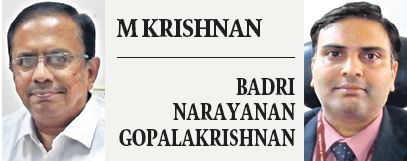Published: Published Date – 12:55 AM, Thu – 16 June 22

By M Krishnan, Badri Narayanan Gopalakrishnan
Agriculture, fisheries and aquaculture startups are no more a preserve of entrepreneurs with an academic background in these core disciplines. They are well populated by cross-discipline incubates that include computer engineers and business graduates with skills in disruptive technologies. These positive blips were seen while evaluating startup project proposals in fisheries and aquaculture submitted to the Biotechnology Industry Research Assistance Council (BIRAC).
Fisheries and aquaculture are an important source of food production, nutritional security, employment and income in India. The fisheries sector is a direct source of livelihood for more than 20 million fishers and fish farmers contributing Rs 1.75 lakh annually to the gross value added of the country’s economy. It is a major export earner, with fish contributing as much as 21% value to agricultural commodities exported from India. The sector has demonstrated an outstanding double-digit average annual growth of 10.87% since 2014-15 with record fish production of 145 lakh tonnes in FY2020-21. India exported 11,49,341 million tonnes of marine products worth Rs 43,717.26 crore ($5.96 billion) during FY21.
Tapping Potential
Realising the sector’s potential, the government has set a national target to increase fish production to 22 million tonnes by 2024-25. This will have a positive impact on 28 million fishers and fish farmers, especially the marginalised and vulnerable communities, and almost twice that number along fish-related value chains.
Human demand for nutrient-rich fish and seafood is already being met with aquaculture and the fisheries sector adopting hi-tech approaches. This momentum in demand for fish picked up with the call of the Ministry of Health and Family Welfare to increase the consumption of fish protein in daily diet during Covid-19. Various projects, which include integration of information technology, data science and artificial intelligence with fishing and aquaculture methods, sustainable exploitation of natural fishery resources and mechanisation-automation of allied activities, are in various stages of fruition.
The different components of disruptive technologies are being engineered for making quick forays into developing tools for mining complex datasets, engaging in analysing cause-effect relationships, forecasting problems and generating smart-precision solutions for aquaculture and marine fisheries.
Attracting Startups
Multiple approaches to infuse disruptive technologies into fisheries and aquaculture are being experimented by startups. AI and IoT-based, low-risk, comprehensive biofloc solution for small-scale fisheries, IoT tools-managed water hyacinth-based fish feeds production, plug-n-play application to sense biological data points driving real-time shrimp farm management systems, IoT devices for black soldier fly farming for fish/shrimp feed production and monitoring, AI and data mining for in-vitro cultured meat from crustaceans, innovative automated cage compass as intelligent floater on water bodies for monitoring, data mining and instant communication are a few of the startups.
The scope of applications of disruptive technologies in fisheries and aquaculture is practically unlimited. The fourth industrial revolution is driven by AI and big data analytics in the background of fisheries technology (AquaTech). The conceptualisation and awareness of such AI-driven AquaTech for achieving efficiency and sustainability of end-to-end operations is growing by the hour.
AI Architecture
In the run-up to the fourth industrial revolution through AquaTech, a Chennai-based company has networked with around 60,000 aquaculture farmers, registering a 5-fold increase in a single year. The company has launched an AI-based networking architecture that includes farm adviser app, virtual store for farm input needs and aquahubs for efficient supply chain. Its remote dashboard builds credit profiles of farmers in real-time and facilitates interest at 12-15%. The company also provides aqua bazaar, a real-time marketing platform for post-harvest market linkage activities.
That’s just one of the fourth industrial revolution companies. It has reportedly increased it revenue 15 times and helped farmers on its platform get better value realisation by 5-10%. It must be noted that this company has only engaged in networking and bringing its farmers and their market up close. With the availability of pre-Series A and debt funding and other sources of boot-strapping finance for startups, the entire horizon of fisheries and aquaculture production and marketing is expanding rapidly.
Public Funding
The fisheries sector has always remained starved of public funding. There are hardly six listed fisheries companies in the stock market and that too in the fish and shrimp feed segment only. Despite FDI in fisheries being 100% open, the sector has not attracted public funding. The fourth industrial revolution companies may be expected to provide the much-needed fillip to corporate investments in aquaculture and marine fisheries.
A word of caution: Cut back to the 1990s and we had a number of public-funded companies making heavy investments in aquaculture. There was nothing virtual about the whole business. Unfortunately, the entire effort went down the drain, practically, owing to the havoc caused by the WSS virus. The fledgling industry crumbled and it took more than a decade to resurrect aquaculture on an even keel. The systemic failure happened owing to the growth of the sector without any backward linkages. Hatchery technology for seed production, pellet feeds, aerators and institutional support and regulatory measures emerged only in the first decade of the current century.
Therefore, AquaTech firms need to grow and populate in a competitive environment as they will deliver the much-needed push to rural growth, employment and income. But again, a think-tank is the need of the hour to deliberate, document and implement the pros and cons of their proliferation to evolve a mechanism that would prevent any pit stops.

(M Krishnan is former Principal Scientist & Head, ICAR – Central Institute of Fisheries Education, Mumbai. Badri Narayanan Gopalakrishnan is Senior Economist, School of Environmental and Forestry Sciences, University of Washington, Seattle)